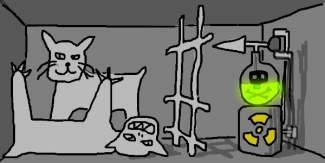The secret for reducing quantum noise in a precision measurement of spins in a collection of a million atoms is simple: Pre-measure the quantum noise, then subtract it out at the end of the precision measurement. The catch is not to do anything that detects and measures the spins of individual atoms in the ensemble. If states of individual atoms are measured, then those atoms stop being in a superposition and the subsequent precision measurement will be ruined.
So, whatever measurement technique is used, it must be a nondemolition measurement that doesn’t alter the quantum state of specific atoms. It must also preserve coherence, i.e., the quantum mechanical phase of each atom before they are probed. If all this sounds hard, that’s because it is. However, Fellow James Thompson and graduate students Zilong Chen, Justin Bohnet, Shannon Shankar, and Jiayan Dai recently succeeded in making a precision coherence-preserving quantum nondemolition measurement of a million cold rubidium (87Rb) atoms inside an optical cavity.
“If we were trying to investigate Schrödinger’s cat (which exists inside a box in a superposition between being alive and being dead),” Thompson says. “We’d be trying not to open the box while we were figuring out what’s in there.
“What we do with our atom ensembles is like putting lots of cats in one box and counting the yowls. We can tell how many cats are still alive, but not which cats!”
The Thompson’s group’s “yowls” are all the signals from the energy levels of the 87Rb atoms. Its “box” is an optical cavity that uses an optical lattice to keep the 87Rb atoms well localized between two mirrors. There, the atoms interact, or “talk” to the cavity resonances. This quantum conversation causes the cavity resonance to split into two (a phenomenon physicists call a vacuum Rabi splitting). The size of the frequency difference between the two resonances depends directly on the number of atoms in a spin-up state.
With their setup, the researchers can accurately and precisely count the total number of atoms in spin-up and spin-down states by scanning a laser across the two resonances. But, they aren’t counting individual atoms, and they have no way of telling which atoms are in a particular spin state.
Coherence is preserved only to the extent that the atoms talk to the universe via the cavity mode. Atoms love to talk to everyone, and like a teenager, it is difficult to get them to hang up the phone. Instead of making them hang up the phone, the atoms are made to talk really quickly to the cavity mode, with the goal of finishing the conversation before the atoms have shared very much information with the rest of the universe. This rapid interaction is accomplished by making the atoms all talk in unison to the cavity mode at a speed that is 1400 times greater than the sum of all the other conversations with the universe.
The researchers found they could reduce quantum noise by using a longer atom-cavity conversation to measure the cavity resonances. However, a longer conversation led to a reduced signal size. Taking this tradeoff into account, the Thompson group was able to surpass the standard quantum limit on quantum phase estimation by a factor of two.
Crucially, their work demonstrated that useful entanglement could be generated in a sample of half a million atoms — comparable to the number of atoms used for state of the art precision measurements. The researchers anticipate that the technique will become an important tool for quantum metrology and spur the development of more precise atomic sensors, magnetometers, rotation and inertial sensors, gravity meters, and atomic clocks. - Julie Phillips





